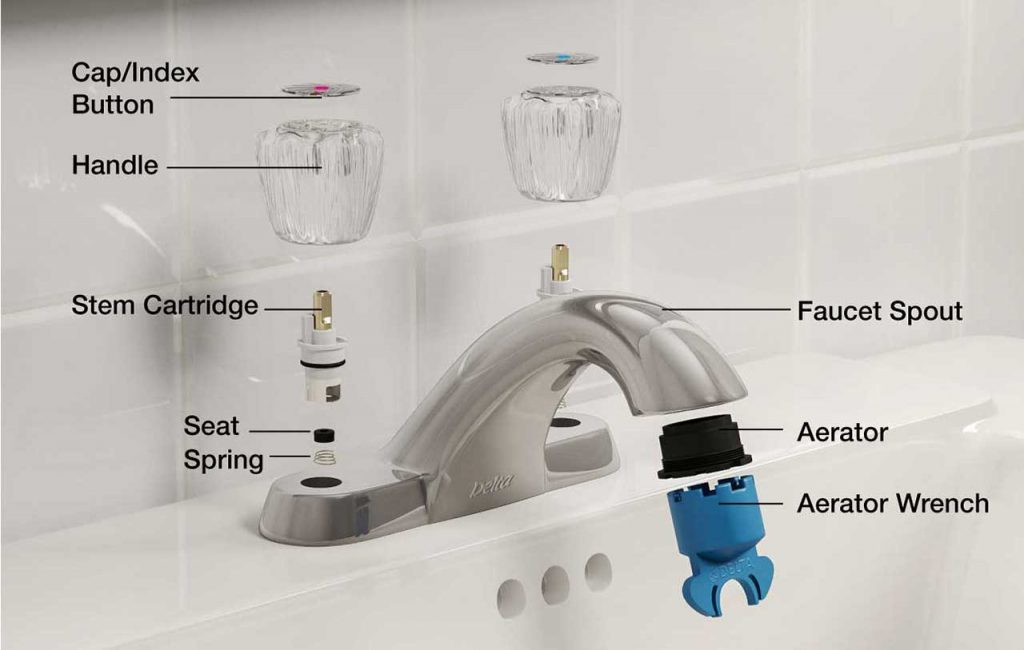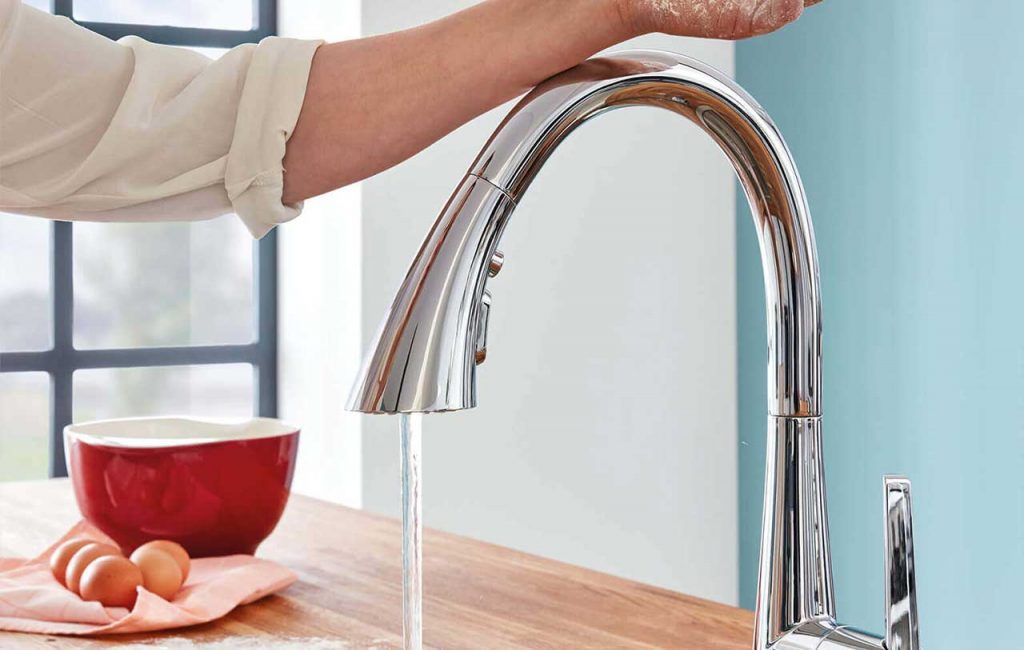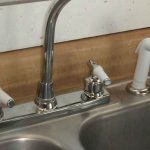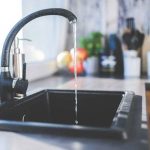The sink faucet is among the commonly used items in the kitchen. Understanding how a kitchen tap works will come in useful when your plumbing system is in trouble.
This post will find the answer to how do kitchen faucets work? by breaking down the anatomy of a kitchen tap. We will also go over the operation of popular types of faucets nowadays.

Compression valve
A compression valve (or compression fitting) is a sort of coupling. It connects a pipe to a fixture. The compression valve comprises three components: the nut, the compression ring, and the base/cap. This type of valve is easy to install and inexpensive, making it a preferable choice in the faucet industry.
Ball valve
A ball valve is a common type of valve for single-handle faucets. A slotted and holed ball, O-rings, and springs make up the structure of a ball valve. The valve is the component that delivers water from the supply system to the sink via the nozzle. The hot and cold water will mingle inside the valve before running out of the tap.
Ceramic disc valve
The ceramic disc valve is innovative for hot and cold kitchen taps. As part of the pressure-balanced cartridge, the cylindrical discs make up the valve. The disc valve raises or lowers to regulate the water as the lever moves.
Handles
They are the components you use to toggle the flow control valve. The handle (or lever) also helps adjust the temperature (for hot and cold taps with a single handle). It usually resides on the top, the sides, or the front part of a fixture.
Cartridge/valves
It is another choice for a faucet valve. A plastic or copper cylinder and an O-ring make up the structure of this valve. A series of channels inside the valve helps manage the flow and temperature of the water. This valve is long-lasting and works with both single- and two-handle taps.
Body
This component holds water coming from the supply line to the fixture. Before running out of the nozzle, water at variable temperatures will mingle in this area.
Spout
The spout is the component that transports water from the line to the sink. To put it another way, here is where the water exits. The spout head design will determine the style of the kitchen tap. There are three main spout options on the market: standard, pot filler, and gooseneck.
Aerator
The aerator (usually made of mesh) splits the stream of water into smaller droplets to infuse them with the air. An aerator reduces the volume of water flowing while maintaining a sense of high-pressure flow. It is of great use to prevent splashing and save energy costs.
Nozzle
Nozzles are a type of kitchen faucet head. It sits at the tip of the spout and increases the flowing force. You can control the direction and pressure of the flow with the aid of a nozzle (from low to high).
Sprayer
The sprayer is a faucet attachment mounted to the fixture. There are three varieties of sprayers on the market today: side spray, pull-out, and pull-down. It helps you direct the water to areas where the tap is inaccessible.
Step By Step Process
You now understand how a faucet works. Let’s learn how to set it up!
Before you begin, make sure you have a wrench, pliers, a bucket, and cleaning clothes on hand. The process also requires supply lines, silicone sealants or caulk, and, of course, a new tap.
Below is a step-by-step installation guide.
Detach The Broken Faucet
Step 1: Close the valve at the bottom of the sink to turn off the supply
Step 2: Use a wrench to disconnect the supply line
Step 3: Disconnect the lift rod, remove the nut from under the faucet
Detach the Draining system
You may need to change the drainpipe if your old system is incompatible with the new faucet. Remember to bring a bucket to catch the water when removing the pipe.
Step 1: Remove the slide nut on the P-trap
Step 2: Remove the flange from its terminal
Step 3: Use diluted dishwashing detergents to remove any silicone stains around the holes
Install Your New Faucet
Step 1: Attach the gasket to the shank of your new fixture
Step 2: Place the faucet in the mounting holes
Step 3: Attach the rubber washer and tighten the nuts on the draining pipe
Step 4: Apply silicone caulk to the flange
Step 5: Connect the drain assembly to the sink
Step 6: Secure the lift rod and the strap
Step 7: Reconnect the supply lines
Voila! You have just finished installing a new kitchen tap. Now is the time to find out the answer to “how do kitchen faucets work?”
How Do Touchless Kitchen Faucets Work?
The touchless kitchen faucet has an infrared receiver and transmitter. When you bring your hand closer or take it away from the faucet head, it detects the heat of your hand.
This transceiver acts as a watchful eye. The valve will automatically open and let the water out when you place your palm in front of the infrared “eye.” When the heat is gone, the valve closes.
Touchless taps require power to function correctly. Some types are powered by dry cell batteries, while others operate on low voltage currents.

How Do Touch Kitchen Faucets Work?
A touch kitchen faucet has a sensor mounted on the faucet’s body. It works the same way as a fingerprint sensor on a smartphone. When you touch it, the valve automatically opens and closes when you tap it a second time.
In more scientific terms, people call this mechanism “capacitance sensing.” The human body emits a small amount of electrical charge, known as capacitance. The sensor works by detecting capacitance in the range of 100-200 picofarads, which is typical of the human body.
With a touch faucet, the user would have more control as you need to physically touch the sensor rather than vaguely make a move in front of it.
How Do Single-Handle Kitchen Faucets Work?
A single-handle faucet lets you turn the water on/off and control the temperature with just one handle. This faucet works with a slotted ball valve aligned with the controlling lever. Hot and cold water lines all pass through this valve.
When you raise the lever, the ball-shaped valve elevates and releases water. A similar mechanism applies when you lower it to turn off the faucet. The valve is also where the fixture mixes the hot and cold water. When you drag the lever to the left or right, the mixing chamber inside moves and helps you adjust the temperature.
How does a two-handle faucet work?
A two-lever faucet is a classic design. It has a compression valve with a washer that controls the flow. The washer opens the valve seat and allows water to flow to the spout when activating the tap. This washer shuts when you lower the lever to halt the flow.
Two-handle taps typically feature two levers: one for hot water and the other for cold water. It is an excellent choice if you want ultimate control over the temperature and how much water goes through the nozzle. Furthermore, if a lever stops working correctly, you can just shut off the supply line on that side. The other lever would be perfectly usable as usual.
How does a pull-down kitchen faucet work?
The pull-down faucet comes with a hand sprayer. Typically, manufacturers equip the manual spray wand with an extended hose within the nozzle. And as the name says, you pull down the spray wand and press the switch to release extra-powerful water to wash out any tough stains.
People also call this type of tap “gooseneck” due to its tall shape. The design makes filling tall pots and kettles a breeze. Furthermore, the elegant look of most pull-down taps can serve as a pretty decoration for your kitchen.
How does a pull-out kitchen faucet work?
A pull-out faucet is similar to the pull-down model in terms of the working mechanism. You pull out the sprayer and direct the water where the nozzle cannot reach in either model. The only difference is how you remove the manual sprayer from the fixture base.
A pull-out kitchen tap typically resides on the sink. Compared with a pull-down design, it provides your kitchen with a more traditional vibe. Pull-out faucets also take up far less area than their pull-down counterparts. This product is ideal for kitchens with cupboards right over the sinks or limited space.
How does a compression faucet work?
A compression faucet works based on the compression mechanism of the valve and rubber sealing ring, with the valve seat working as a link to the spout. The fixture utilizes a large screw-like stem and a washer at the tip of the slotted area. When you raise or lower the lever, the compression valve gets tightened or vice versa. Then the rubber washer moves accordingly around the stem to block or discharge water.
Due to such a mechanism, compression taps are prone to leakage. After frequent use, the rubber washer might get distorted or fall to pieces. Residues can also build up over time and erode the valve seat. They are the main reasons for leaks around the gadget.
How does a cartridge faucet work?
A cartridge faucet works with a washerless cartridge valve. Its working process follows the diverter mechanism of the cylinder. This type of faucet has supply lines that run from the base of the fixture to the nozzle. Hot and cold water enters the mixing chamber within the cartridge through this inlet. A network of channels inside the cylinder then controls the temperature as the water flows.
The O-ring seals the bottom of the cartridge, preventing leaking from the edges. The faucet’s handles spin the cartridge within to regulate how much water falls out when turning the handle on or off.
How does a pot filler faucet work?
A pot-filler faucet is also known as a kettle faucet or a pasta arm. It typically resides near the hob or cooker. The pot filler can glide out and stretch across a long, adjustable arm.
With this, you can pour water straight into the pot on the stove. The long metal neck is foldable, so you can tuck it back when not in use to conserve space. Pot fillers help you fill a pot at a flow rate of 4.0 gallons/minute, nearly three times faster than with a traditional kitchen faucet.
How does a separate spray faucet work?
A separate spray faucet operates the same way as a drop-down faucet. The only distinction is that the side sprayer is a separate device rather than an integrated spray head.
This sort of faucet requires an extra hole in the kitchen basin. Due to the diverter mechanism, you need to hold the trigger to release water, and there is generally no lock-spray option. When you press the trigger, the water travels through the faucet and is diverted to the sprayer.
Conclusion
We hope you found the answer you needed for “how do kitchen faucets work?” Having a basic understanding of fixture parts might be helpful when there is no plumber available. You can quickly install your kitchen tap with only a few simple mechanical tools.




